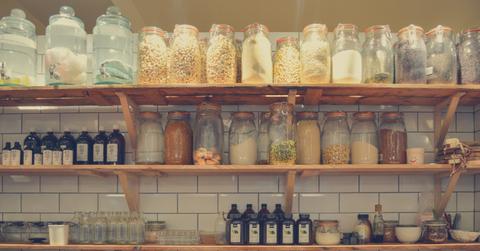Experts Weigh In On Taking Your Kitchen From Wasteful To Waste-Free
Three leaders in the zero-waste movement dish on how to reduce refuse in the most wasteful room of the house: the kitchen.
Updated May 17 2019, 8:04 p.m. ET
It’s easy to succumb to the greenwashing of eco-friendly packaging.
Buzzwords like recycled, organic, compostable and recyclable convince us to buy additional products just because they say they’re better for the environment. But the central ethos of reducing our impacts and waste has to start with buying high-quality and long-lasting items, and end with nothing getting tossed out (even if it’s being thrown into a recycle bin).
Nowhere in our lives is this process more difficult than in the kitchen. From the excessive packaging on food to the wastefulness of food storage methods, the kitchen ends up being one of the most wasteful zones of the home. Composting is simply not enough to counteract the onslaught of garbage that comes with virtually every meal. So we talked to three heavyweights in the zero-waste movement about how to turn a kitchen from wasteful to waste-free.
Lily Cameron, The Wild Minimalist
Lily Cameron founded The Wild Minimalist with her husband Max after a trip backpacking through the Pacific Northwest and visiting the French countryside. Living so minimally inspired the couple (then engaged, now married) to go zero-waste — and to help other people get on board, too.
This work resulted in the pair’s website, which serves as a one-stop shop for reusable, "timeless alternatives" to throwaway items in everyday life. "I’ve found that the kitchen is the single biggest source of disposable plastic in the home, and there are so many simple ways to combat this waste," Cameron told Green Matters in an interview.
"I suggest preventing plastic from entering your kitchen in the first place by greening your grocery shopping routine. Bringing reusable canvas bags to the market is a great start, but take it a step further and bring reusable produce bags. These bags are super versatile and can be used for fruits and veggies, but also bulk items like grains, nuts, legumes, flour and chocolate."
Cameron takes it a step further, urging people to buy wet items such as fresh nut butter, olives, and bulk liquid soap in glass jars brought from home. "You just have to weigh your jar first (so the cashier can deduct it from the weight of the item you're buying) and be sure to check in with your local grocery store to make sure they accept bringing your own jar," she said.
"Once you start cutting down on the plastic entering home, it becomes easier to pay attention to what else is disposable in your kitchen. Pay attention to what you're throwing away, and then look into reusable alternatives. Instead of plastic sponges, switch to compostable wood dish brushes. Instead of paper towels, switch to reusable cloth 'unpaper' towels. I could go on!"
Here are Lily Cameron’s top product picks for reducing kitchen waste:
Bea Johnson, Zero Waste Home
Bea Johnson is an author, speaker, and influencer who founded ZeroWasteHome.com, a blog about waste-free living and the global rise of the zero-waste lifestyle movement. Johnson’s best-selling book has been translated into more than 20 languages, and her Facebook, Twitter and Instagram followers number in the hundreds of thousands. Best part is, Johnson walks the walk. She and her family have been zero waste for a decade, producing just a pint jar of trash every year.
Their secret? What Johnson calls the 5R’s: “Refuse, Reduce, Reuse, Recycle, Rot, and only in that order.” “To eliminate packaging, we buy our food loose, using reusables: totes, cloth bags and jars,” she told Green Matters in an interview.
Johnson had a lot of other tips for keeping waste out of the kitchen, too. Here's a list of the principles she shared:
Anne-Marie Bonneau, Zero Waste Chef
Anne-Marie Bonneau has lived plastic-free since 2011, working her way up to existing today with virtually zero waste. Bonneau lives in an intentional community in the San Francisco Bay Area, works as senior editor of a small publisher, and has two kids. And still, this busy person has managed to live without waste.
Her secret lies in three basic rules: “No packaging. Nothing processed. No trash.” Her no-nonsense approach to ditching waste begged the question: How can the average person move toward zero waste?
"My number-one tip is to cook real food," Bonneau told Green Matters. "So much plastic trash in our waste stream comes from food packaging for processed food, which isn't healthy for us or the planet. So cut the shiny packages — chips, soda, cookies, frozen pizzas, fast food and so on — and you not only eliminate a ton of trash, you improve your diet and health. You'll eat more fresh produce (vegetables have their own package, for example) and you learn what to do with food already in your kitchen before you buy more. That will help reduce food waste also, which is a serious problem as foot rotting in landfill, cut off of oxygen as it so tightly compacted, releases methane gas as it decomposes — a greenhouse gas much more potent than carbon dioxide."
Bonneau stressed the importance of taking first steps to reduce waste. "You may feel paralyzed to start because when you begin to become conscious of plastic, you see it everywhere. That's because it is everywhere! So you could start by no longer buying bottled water, by taking a reusable mug or thermos to your local café, or by shopping at the farmers' market for loose produce. Next, refuse single-use plastic like shopping bags (use cloth ones), produce bags (again, use cloth ones), straws, plastic utensils and stir sticks. Start small and keep going. It's a journey."
